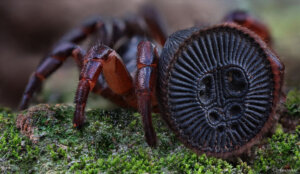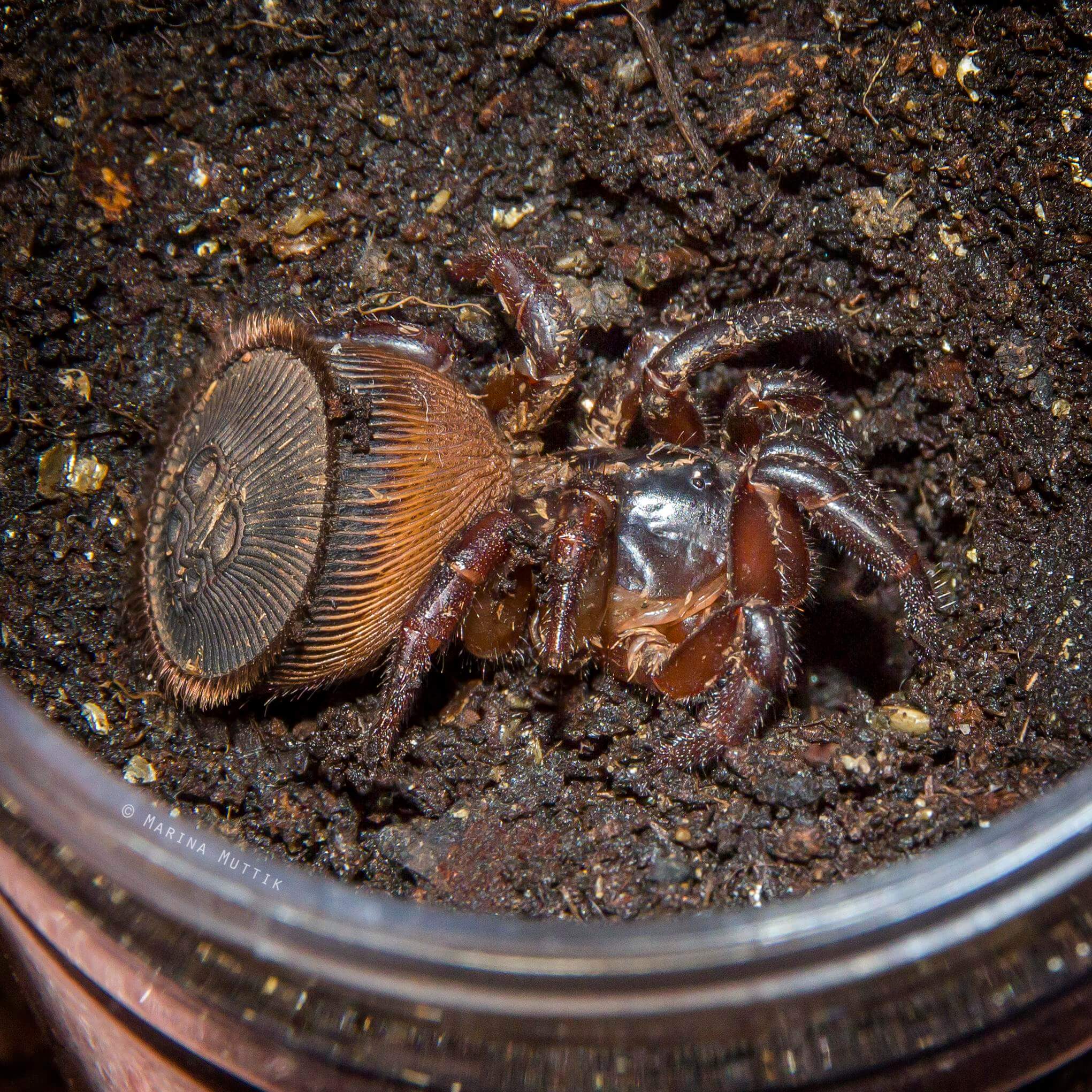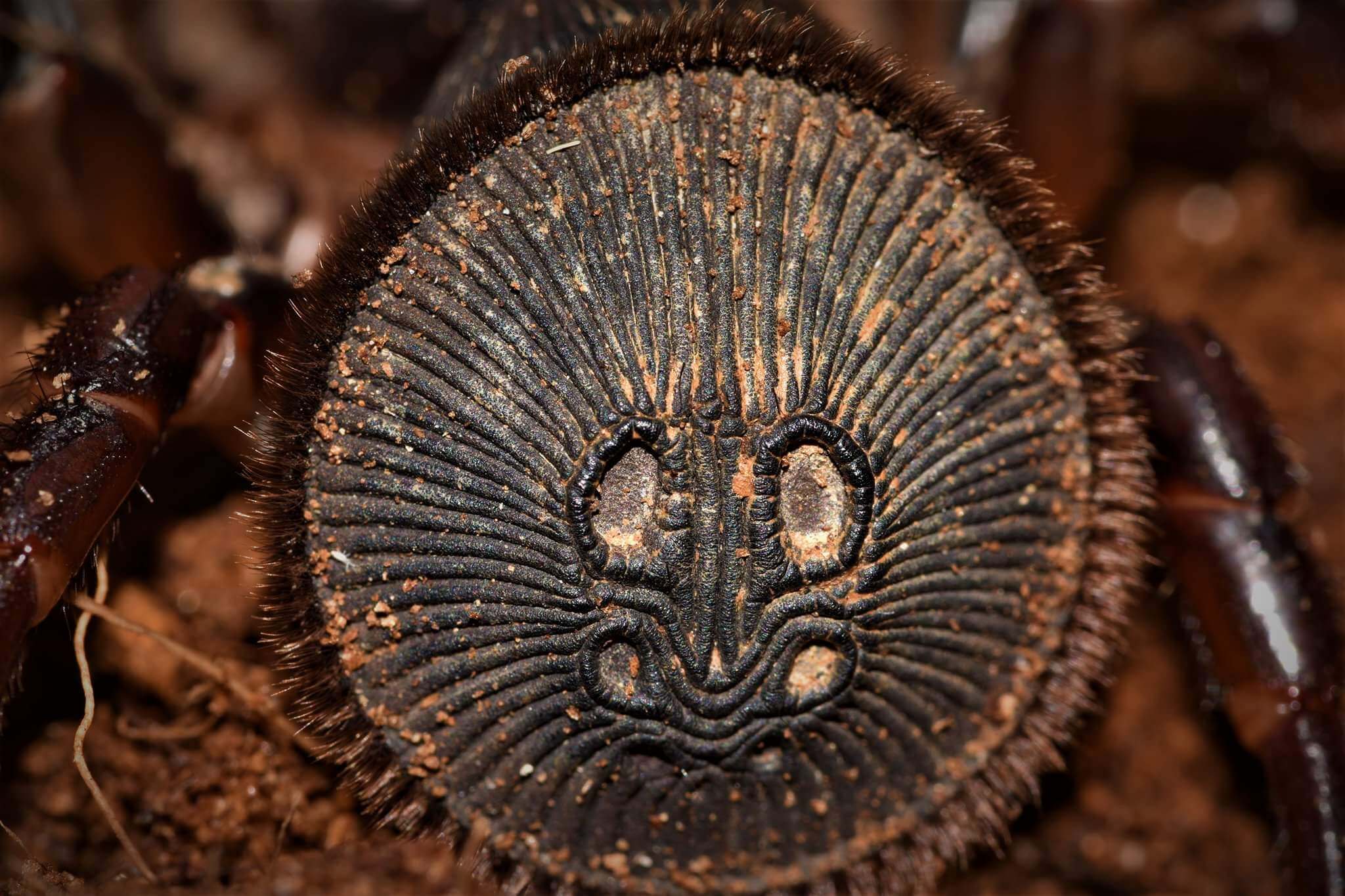Chinese Hourglass Spider: Is It Dangerous?


Written and verified by the biologist Cesar Paul Gonzalez Gonzalez
The Chinese hourglass spider is a peculiar invertebrate that has an iconic symbol on its “abdomen”, which give it the “hourglass” name, although in some countries it’s called the “money trapdoor spider”, alluding to what appears to be a coin at the end of its body. In reality, this aspect is a defensive mechanism that allows it to confront various aggressors in its surroundings.
Contrary to popular belief, there’s not only one species of hourglass spider, but several grouped in the same taxonomic genus (Cyclocosmia). Of course, they all have the same symbol on their abdomen, so the specific differences between them aren’t so obvious.
Although the hourglass spider is venomous, its toxins aren’t a threat to humans. Want to find out more about this curious arachnid? Read on!
Chinese hourglass spider taxonomy
Chinese hourglass spiders belong to the genus Cyclocosmia, within the family Halonoproctidae. According to the official website of the World Spider Catalog, there are 11 taxonomically valid species in this group. However, the so-called Chinese hourglass spiders are characterized by being very elusive and difficult to see in their habitat, so there may be more unidentified species.
For a long time, the Chinese hourglass spiders were part of the family Ctenizidae, which groups some of the popular trapdoor spiders. Although they have similar behavior, different specialists mentioned that there were inconsistencies in their phylogenetic relationships.
In 2018, a study published in the journal Molecular Phylogenetics and Evolution established the current taxonomic classification based on molecular analysis. Thanks to this, it was identified that the Chinese hourglass spider is most closely related to the genera Bothriocyrtum, Conothele, Hebestatis, Latouchia, and Ummidia (family Halonoproctidae).

Habitat and distribution of the Chinese hourglass spider
The genus Cyclocosmia has a relatively wide distribution. According to a study in the journal Zookeys magazine, at least one species can be found in the following countries:
- Mexico
- United States
- China
- Vietnam
- Guatemala
- Thailand
However, their presence seems to be very limited by their habits, because they’re sedentary arachnids that don’t usually move around much. In this sense, the habitat of these spiders consists of clayey, humid soils, with steep slopes and a great abundance of leaf litter, as mentioned in an article published in The Raffles Bulletin of Zoology.
These environments make it easier for them to dig their burrows and hide in them, which makes them more elusive to humans.
Physical characteristics of the genus Cyclocosmia
Like other spiders, members of the genus Cyclocosmia have a body divided into two distinct oval regions, which are as follows:
- Prosoma: This is the front part of the spider and contains the eyes, mouth and limbs.
- Opisthosoma: This is the “hourglass-shaped” section containing the sexual organs and silk glands.
Chinese hourglass spiders average between 17 and 30 millimeters in length. In addition, according to a study published in the journal Biodiversity Data Journal, its body is somewhat robust and may exhibit white “hairs” on its belly.
The colorations of Cyclocosmia spiders are cryptic, so they exhibit dull brown and yellow tones that blend well with the color of the ground. This is essential to their survival because it allows them to camouflage within burrows.
Extremities
At first glance, the Chinese hourglass spider appears to have 10 legs. However, this is only a misinterpretation of its limbs, since the first two – counting from its mouth – are actually “accessory mouthparts”. These don’t help them move, but their function is closer to the “hands” of humans.
The name, number, and characteristics of the limbs of the genus Cyclocosmia can be classified as follows:
- Chelicerae: One pair (2 in total). These are part of the mouth and their appearance resembles two prominent teeth. Their function is to trap, “crush” and inject venom into prey.
- Pedipalps: One pair (2 in total). These are located on each side of the mouth and their appearance is similar to that of the other legs, except that they’re slightly smaller. Their function is to manipulate and sense the different elements of their environment (as if they were their hands).
- Locomotor legs: 4 pairs (8 in total). These are the longest limbs and are used for movement.
Opisthosoma with an “hourglass” or “coin” shape
The most distinctive feature of the genus Cyclocosmia is the presence of the “hourglass” or “coin” shaped disk. This is located in the posterior part of the opisthosoma, is flattened, and has several rings around it. According to an article published in the journal Zootaxa magazine, this area is sclerotized (hard) and resistant, because it plays a defensive role when sheltering in its burrow.
Is the Chinese hourglass spider’s venom dangerous?
As with other arachnids, the coin-head spider is also poisonous. However, the toxins it produces are not considered a potential risk to humans because their effect is small and not very noticeable.
Although there are no studies on the composition of the venom of these spiders, it has been observed that their closest relatives are harmless to humans. In fact, according to a study published in the journal Toxicon, the toxins of the species Hebestatis theveniti – related to Cyclocosmia – are only able to temporarily paralyze their prey (small arthropods).
Some years ago, false news began to be shared on social networks about the serious danger of encountering a Chinese hourglass spider.
Of course, this was only a sensationalist rumor that was denied by several specialists some time later. Moreover, even the Autonomous University of Chihuahua published a note to clarify the issue and avoid panic among people.
These spiders don’t tend to be overly aggressive, so they’ll only bite a human being if they perceive an imminent risk.
Also, due to their habits and distribution, it’s rare to have contact with them inside the home. For this reason, the genus Cyclocosmia isn’t considered dangerous for people.
Behavior of the Chinese hourglass spider
As mentioned above, the Chinese hourglass spider is characterized by its ability to dig burrows or tunnels in the ground that serve as shelter. In addition, it also builds a “door” with sediment and its web, which allows it to block the entrance and prevent unwanted intruders.
In addition, these species have a second level of security, since they use their opisthosoma as a false bottom. That is, they block the entrance and arrange themselves so that their “disk” faces the entrance. Thus, should a predator manage to get through their door, they are unlikely to be detected because they camouflage themselves with their “coin” appearance.

Chinese hourglass spider feeding
Chinese hourglass spiders are carnivorous and feed on various types of insects or small arthropods. As for their hunting strategy, they may use two:
- Active hunting: It searches for and attacks its prey.
- Passive hunting: It waits in its burrow for prey to approach.
Although there are some mentions of these strategies used by this spider to hunt its prey, the reality is that this behavior hasn’t yet been fully documented. Therefore, there are likely to be many other secrets about its life as a predator still to be discovered.
Arachnid secrets to be revealed
As you may realize, the Chinese hourglass spider is not a very dangerous arachnid. Although we still don’t know too much about it, its complex behavior and appearance have made it famous in many parts of the world. However, we still need to find out much more about it, so we can only wait for specialists to reveal their secrets.
The Chinese hourglass spider is a peculiar invertebrate that has an iconic symbol on its “abdomen”, which give it the “hourglass” name, although in some countries it’s called the “money trapdoor spider”, alluding to what appears to be a coin at the end of its body. In reality, this aspect is a defensive mechanism that allows it to confront various aggressors in its surroundings.
Contrary to popular belief, there’s not only one species of hourglass spider, but several grouped in the same taxonomic genus (Cyclocosmia). Of course, they all have the same symbol on their abdomen, so the specific differences between them aren’t so obvious.
Although the hourglass spider is venomous, its toxins aren’t a threat to humans. Want to find out more about this curious arachnid? Read on!
Chinese hourglass spider taxonomy
Chinese hourglass spiders belong to the genus Cyclocosmia, within the family Halonoproctidae. According to the official website of the World Spider Catalog, there are 11 taxonomically valid species in this group. However, the so-called Chinese hourglass spiders are characterized by being very elusive and difficult to see in their habitat, so there may be more unidentified species.
For a long time, the Chinese hourglass spiders were part of the family Ctenizidae, which groups some of the popular trapdoor spiders. Although they have similar behavior, different specialists mentioned that there were inconsistencies in their phylogenetic relationships.
In 2018, a study published in the journal Molecular Phylogenetics and Evolution established the current taxonomic classification based on molecular analysis. Thanks to this, it was identified that the Chinese hourglass spider is most closely related to the genera Bothriocyrtum, Conothele, Hebestatis, Latouchia, and Ummidia (family Halonoproctidae).

Habitat and distribution of the Chinese hourglass spider
The genus Cyclocosmia has a relatively wide distribution. According to a study in the journal Zookeys magazine, at least one species can be found in the following countries:
- Mexico
- United States
- China
- Vietnam
- Guatemala
- Thailand
However, their presence seems to be very limited by their habits, because they’re sedentary arachnids that don’t usually move around much. In this sense, the habitat of these spiders consists of clayey, humid soils, with steep slopes and a great abundance of leaf litter, as mentioned in an article published in The Raffles Bulletin of Zoology.
These environments make it easier for them to dig their burrows and hide in them, which makes them more elusive to humans.
Physical characteristics of the genus Cyclocosmia
Like other spiders, members of the genus Cyclocosmia have a body divided into two distinct oval regions, which are as follows:
- Prosoma: This is the front part of the spider and contains the eyes, mouth and limbs.
- Opisthosoma: This is the “hourglass-shaped” section containing the sexual organs and silk glands.
Chinese hourglass spiders average between 17 and 30 millimeters in length. In addition, according to a study published in the journal Biodiversity Data Journal, its body is somewhat robust and may exhibit white “hairs” on its belly.
The colorations of Cyclocosmia spiders are cryptic, so they exhibit dull brown and yellow tones that blend well with the color of the ground. This is essential to their survival because it allows them to camouflage within burrows.
Extremities
At first glance, the Chinese hourglass spider appears to have 10 legs. However, this is only a misinterpretation of its limbs, since the first two – counting from its mouth – are actually “accessory mouthparts”. These don’t help them move, but their function is closer to the “hands” of humans.
The name, number, and characteristics of the limbs of the genus Cyclocosmia can be classified as follows:
- Chelicerae: One pair (2 in total). These are part of the mouth and their appearance resembles two prominent teeth. Their function is to trap, “crush” and inject venom into prey.
- Pedipalps: One pair (2 in total). These are located on each side of the mouth and their appearance is similar to that of the other legs, except that they’re slightly smaller. Their function is to manipulate and sense the different elements of their environment (as if they were their hands).
- Locomotor legs: 4 pairs (8 in total). These are the longest limbs and are used for movement.
Opisthosoma with an “hourglass” or “coin” shape
The most distinctive feature of the genus Cyclocosmia is the presence of the “hourglass” or “coin” shaped disk. This is located in the posterior part of the opisthosoma, is flattened, and has several rings around it. According to an article published in the journal Zootaxa magazine, this area is sclerotized (hard) and resistant, because it plays a defensive role when sheltering in its burrow.
Is the Chinese hourglass spider’s venom dangerous?
As with other arachnids, the coin-head spider is also poisonous. However, the toxins it produces are not considered a potential risk to humans because their effect is small and not very noticeable.
Although there are no studies on the composition of the venom of these spiders, it has been observed that their closest relatives are harmless to humans. In fact, according to a study published in the journal Toxicon, the toxins of the species Hebestatis theveniti – related to Cyclocosmia – are only able to temporarily paralyze their prey (small arthropods).
Some years ago, false news began to be shared on social networks about the serious danger of encountering a Chinese hourglass spider.
Of course, this was only a sensationalist rumor that was denied by several specialists some time later. Moreover, even the Autonomous University of Chihuahua published a note to clarify the issue and avoid panic among people.
These spiders don’t tend to be overly aggressive, so they’ll only bite a human being if they perceive an imminent risk.
Also, due to their habits and distribution, it’s rare to have contact with them inside the home. For this reason, the genus Cyclocosmia isn’t considered dangerous for people.
Behavior of the Chinese hourglass spider
As mentioned above, the Chinese hourglass spider is characterized by its ability to dig burrows or tunnels in the ground that serve as shelter. In addition, it also builds a “door” with sediment and its web, which allows it to block the entrance and prevent unwanted intruders.
In addition, these species have a second level of security, since they use their opisthosoma as a false bottom. That is, they block the entrance and arrange themselves so that their “disk” faces the entrance. Thus, should a predator manage to get through their door, they are unlikely to be detected because they camouflage themselves with their “coin” appearance.

Chinese hourglass spider feeding
Chinese hourglass spiders are carnivorous and feed on various types of insects or small arthropods. As for their hunting strategy, they may use two:
- Active hunting: It searches for and attacks its prey.
- Passive hunting: It waits in its burrow for prey to approach.
Although there are some mentions of these strategies used by this spider to hunt its prey, the reality is that this behavior hasn’t yet been fully documented. Therefore, there are likely to be many other secrets about its life as a predator still to be discovered.
Arachnid secrets to be revealed
As you may realize, the Chinese hourglass spider is not a very dangerous arachnid. Although we still don’t know too much about it, its complex behavior and appearance have made it famous in many parts of the world. However, we still need to find out much more about it, so we can only wait for specialists to reveal their secrets.
All cited sources were thoroughly reviewed by our team to ensure their quality, reliability, currency, and validity. The bibliography of this article was considered reliable and of academic or scientific accuracy.
- De Luna, M., Solís Rojas, C., García Barrios, R., & Millan, A. B. (2021). New data on Cyclocosmia loricata (CL Koch, 1842)(Aranei: Halonoproctidae) with first description of the male palp. Arthropoda Selecta, 30(1), 89-93. http://eprints.uanl.mx/24858/
- Godwin, R. L., Opatova, V., Garrison, N. L., Hamilton, C. A., & Bond, J. E. (2018). Phylogeny of a cosmopolitan family of morphologically conserved trapdoor spiders (Mygalomorphae, Ctenizidae) using Anchored Hybrid Enrichment, with a description of the family, Halonoproctidae Pocock 1901. Molecular Phylogenetics and Evolution, 126, 303-313. https://www.sciencedirect.com/science/article/abs/pii/S1055790317307704?via%3Dihub
- Isbister, G. K., & White, J. (2004). Clinical consequences of spider bites: recent advances in our understanding. Toxicon, 43(5), 477-492. https://www.sciencedirect.com/science/article/abs/pii/S0041010104000546
- Lin, Y. J., Yu, L., Yan, X., & Li, S. (2022). First description of the male of Cyclocosmiaricketti (Araneae, Halonoproctidae) from China. Biodiversity Data Journal, 10. https://bdj.pensoft.net/article/79205/
- Rash, L. D., & Hodgson, W. C. (2002). Pharmacology and biochemistry of spider venoms. Toxicon, 40(3), 225-254. https://www.sciencedirect.com/science/article/abs/pii/S0041010101001994
- Schwendinger, P. J. (2005). Two new Cyclocosmia (Araneae: Ctenizidae) from Thailand. Revue suisse de Zoologie, 112(1), 225-252. https://www.researchgate.net/publication/284641975_Two_new_Cyclocosmia_Araneae_Ctenizidae_from_Thailand
- Skinner, W. S., Dennis, P. A., Lui, A., Carney, R. L., & Quistad, G. B. (1990). Chemical characterization of acylpolyamine toxins from venom of a trap-door spider and two tarantulas. Toxicon, 28(5), 541-546. https://www.sciencedirect.com/science/article/abs/pii/004101019090298L
- Universidad Autónoma de Chihuahua. (2020, 6 de marzo). El mito de la “Araña sello” o “Cabeza de moneda” y otros arácnidos en Chihuahua. Consultado el 3 de junio de 2023. https://uach.mx/noticias/2020/3/6/el-mito-de-la-arania-sello-o-cabeza-de-moneda-y-otros-aracnidos-en-chihuahua/
- World Spider Catalog. (2023, 10 de abril). Gen. Cyclocosmia Ausserer, 1871. Consultado el 3 de junio de 2023. https://wsc.nmbe.ch/genusdetail/651
- Xu, X., Xu, C., Li, F., Pham, D. S., & Li, D. (2017). Trapdoor spiders of the genus Cyclocosmia Ausserer, 1871 from China and Vietnam (Araneae, Ctenizidae). ZooKeys, (643), 75. https://www.ncbi.nlm.nih.gov/pmc/articles/PMC5242268/
- Yu, K., & Zhang, Z. S. (2018). On three species of the trapdoor spider Genus Cyclocosmia from China (Araneae, Halonoproctidae). Zootaxa, 4532(2), 248-256. https://www.researchgate.net/publication/329757173_On_three_species_of_the_trapdoor_spider_Genus_Cyclocosmia_from_China_Araneae_Halonoproctidae
- Zhu, M. S., Zhang, J. X., & Zhang, F. (2006). Rare spiders of the genus Cyclocosmia (Arachnida: Araneae: Ctenizidae) from tropical and subtropical China. The Raffles Bulletin of Zoology, 54, 119-124. https://www.researchgate.net/publication/268264968_Rare_spiders_of_the_genus_Cyclocosmia_Arachnida_Araneae_Ctenizidae_from_tropical_and_subtropical_China
This text is provided for informational purposes only and does not replace consultation with a professional. If in doubt, consult your specialist.








